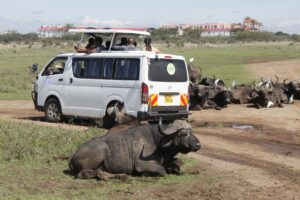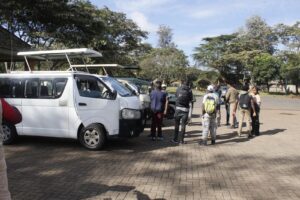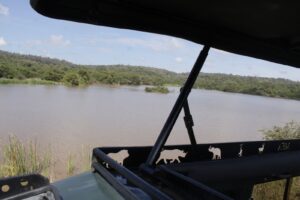The Real Story of Great Wildebeest Migration

The Great Wildebeest Migration is one of the most spectacular wildlife events on the planet, often referred to as the “Greatest Show on Earth.” Taking place annually across the vast plains of East Africa, it is a natural phenomenon that draws thousands of wildlife enthusiasts and travelers to the Maasai Mara in Kenya and the Serengeti in Tanzania. Here’s the story of this incredible migration and why you should visit the Maasai Mara to witness it.
The Story of the Great Wildebeest Migration
The Journey of Survival
The Great Wildebeest Migration is an epic journey involving over 1.5 million wildebeest, along with hundreds of thousands of zebras, gazelles, and other herbivores. The migration is driven by the search for fresh grazing grounds and water, following the seasonal rains across the Serengeti-Mara ecosystem.
The Cycle of Migration
- Calving Season (January – March): The migration begins in the southern Serengeti, where the wildebeest give birth to approximately 500,000 calves within a span of a few weeks. This period is marked by an abundance of food, but also by the presence of predators like lions, cheetahs, and hyenas, who take advantage of the vulnerable newborns.
- The Move North (April – June): As the rains cease and the grass in the southern Serengeti dries up, the herds begin their journey northward. This is a perilous time as they face predators, exhaustion, and the challenge of crossing rivers infested with crocodiles.
- The Grumeti and Mara River Crossings (July – September): One of the most dramatic events of the migration occurs as the herds reach the Grumeti and Mara Rivers. The wildebeest must cross these rivers, where giant Nile crocodiles lie in wait. The crossings are chaotic, with stampedes, drownings, and predator attacks, but they are also a testament to the resilience and determination of these animals.
- Grazing in the Maasai Mara (July – October): After surviving the treacherous river crossings, the herds arrive in the Maasai Mara in Kenya, where they feast on the lush grasslands. This is the peak time to witness the migration in the Maasai Mara, as the plains are teeming with life and the predator-prey interactions are at their most intense.
- The Return Journey (November – December): As the short rains begin in the Serengeti, the herds start their journey back south, completing the cycle of migration. The grass in the southern Serengeti rejuvenates, offering fresh grazing grounds for the next calving season, and the migration continues its eternal cycle.
Why You Should Visit the Maasai Mara to Witness the Migration
1. Unparalleled Wildlife Spectacle
- The Maasai Mara is one of the best places in the world to witness the Great Wildebeest Migration in all its glory. The sheer number of animals, the dramatic river crossings, and the predator-prey interactions make for an unforgettable wildlife experience. The Maasai Mara’s open plains offer excellent visibility, ensuring you won’t miss any of the action.
2. Prime Viewing of River Crossings
- The Mara River crossing is one of the most thrilling and iconic events of the migration. Watching thousands of wildebeest plunge into the crocodile-infested waters, driven by instinct and the need to survive, is a heart-pounding experience. The Maasai Mara offers some of the best vantage points to witness this dramatic event.
3. Abundant Wildlife
- Besides the wildebeest, the Maasai Mara is home to an incredible diversity of wildlife, including the Big Five (lion, leopard, elephant, buffalo, and rhino). The abundance of prey during the migration attracts large numbers of predators, making it one of the best times for game viewing and photography.
4. Rich Cultural Experience
- The Maasai Mara is named after the Maasai people, who are known for their rich culture and traditions. Visiting the Maasai Mara offers a unique opportunity to engage with the Maasai community, learn about their way of life, and experience their warm hospitality. Cultural visits to Maasai villages can provide a deeper understanding of the coexistence between humans and wildlife in this region.
5. Luxurious Safari Accommodations
- The Maasai Mara offers a range of luxurious safari lodges and camps, providing comfort and style in the heart of the wilderness. These accommodations offer guided game drives, bush walks, and even hot air balloon safaris, allowing you to experience the migration from different perspectives.
6. Year-Round Appeal
- While the migration is the highlight, the Maasai Mara is a year-round safari destination. Even outside of migration season, the Mara’s resident wildlife populations are abundant, and the landscape remains stunningly beautiful, offering a fantastic safari experience any time of the year.
The Magic of the Migration
Witnessing the Great Wildebeest Migration in the Maasai Mara is not just a safari, but a profound and awe-inspiring encounter with nature at its most raw and powerful. The sight of millions of animals moving as one, the sounds of hooves thundering across the plains, and the tension of predator and prey interactions create a truly magical experience.
Whether you’re a seasoned safari-goer or a first-time visitor, the Maasai Mara during the migration offers an unmatched wildlife spectacle that will leave you with memories to last a lifetime.







